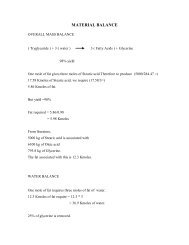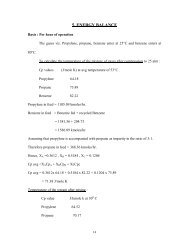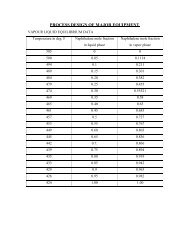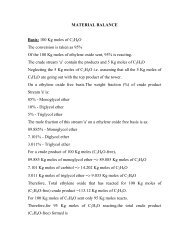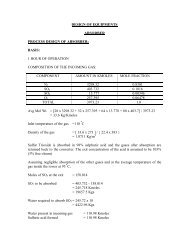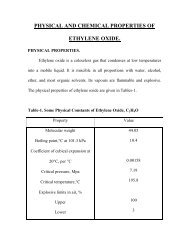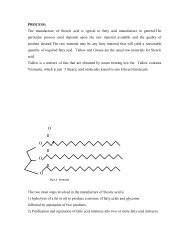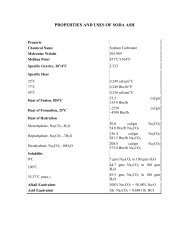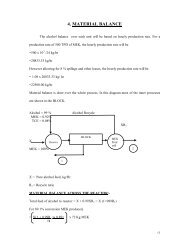Sulfuric Acid Material Balance
Sulfuric Acid Material Balance
Sulfuric Acid Material Balance
You also want an ePaper? Increase the reach of your titles
YUMPU automatically turns print PDFs into web optimized ePapers that Google loves.
MATERIAL BALANCE<br />
GIVEN:<br />
TO DESIGN A 1000TPD CAPACITY H 2<br />
SO 4<br />
ACID PLANT<br />
BASIS:<br />
1 HOUR OF OPERATION.<br />
PURITY:<br />
PRODUCT WHICH IS TO BE MANUFACTURED IS ASSUMED TO HAVE<br />
STRENGTH OF 98% ACID.<br />
1000TPD implies that we have<br />
<strong>Acid</strong><br />
1000 x 10 3 / 24 = 41666.67 Kg/Hr of<br />
With 98% purity, the acid that is produced per hour = (98 x 41666.67)<br />
/ 100<br />
= 40833.34 Kg/Hr<br />
Kmoles of <strong>Sulfuric</strong> acid to be produced = 40833.34 / 98<br />
= 416.667 Kmoles/Hr<br />
It’s assumed that overall absorption of the acid is 100 %<br />
Then, SO 3<br />
required = 416.667 / 1.0<br />
= 416.67 Kmoles/Hr<br />
Also its assumed that the overall conversion of SO 2<br />
to SO 3<br />
in the reactor<br />
is 99.8%<br />
Then SO 2<br />
required = 416.67 / 0.998<br />
= 417.51Kmoles/Hr<br />
Assuming 100% combustion of Sulfur,<br />
Then S required<br />
= 417.5 Kmoles/Hr<br />
= 13360.3 Kgs<br />
Amount of oxygen required to convert 1Kmole of S to SO 3<br />
= 1.5 Kmoles<br />
Then, amount of Oxygen required = 417.51 x 1.5<br />
= 626.26 Kmoles
As cited in the literature that some amount of excess oxygen must be<br />
used,<br />
Using 40% excess,<br />
O 2<br />
required = 626.26 x 1.4<br />
= 876.76 Kmoles<br />
From this the total dry air that is coming in can be calculated as.<br />
Dry air in = (876.76 x 100)/ 21<br />
= 4175 Kmoles/Hr<br />
At 30 • C, assuming 65% Relative Humidity,<br />
Humidity as calculated from the psychometric chart is,<br />
Humidity = 0.0165 Kg water/ Kg dry air<br />
Then, water entering with dry air = 4175 x 29 x 0.0165<br />
= 1997.73 Kg/Hr<br />
= 110.980 Kmoles/Hr<br />
Total weight of entering air = 4175 x 29 + 110.980 x 18<br />
= 123073 Kgs<br />
DRYING TOWER:<br />
Q (121075 Kgs)<br />
(Dry Air)<br />
R (193806 Kgs)<br />
P (123073<br />
Kgs)<br />
S (195804 Kgs)
Making a Mass balance around the Drying Tower<br />
P + R = Q + S<br />
As water is being removed from the incoming air to make it dry, the 98%<br />
acid that is being recycled to the tower, decreases in concentration and<br />
let this concentration be assumed as 97%, then we can write,<br />
0.02 x R + 1998 = S x 0.03 (1)<br />
H 2<br />
SO 4<br />
<strong>Balance</strong> will give,<br />
R x 0.98 = S x 0.97 (2)<br />
Solving the above equations<br />
R = 193806 Kgs<br />
S = 195804 Kgs<br />
SULFUR BURNER:<br />
SULFUR (13360.3 Kgs)<br />
DRY AIR<br />
SO 2<br />
(26720.6 Kgs)<br />
(121075Kgs) O 2<br />
(14696<br />
Kgs)<br />
N 2<br />
(92352.4<br />
Kgs)<br />
The combustion reaction takes place inside the burner where Sulphur is<br />
oxidized to Sulphur Dioxide<br />
Moles of Sulfur coming in<br />
Moles of Oxygen coming in<br />
= 417.51 Kmoles<br />
= 876.76 Kmoles<br />
As mentioned before we have assumed 100% combustion of sulphur,<br />
Sulfur Dioxide Formed = 417.51 Kmoles<br />
Oxygen leaving = 876.76 – 417.51<br />
= 459.25 Kmoles<br />
Nitrogen leaving = (876.76 x 79)/ 21<br />
= 3298.3 Kmoles
REACTOR:<br />
As cited in the reference by author NORMAN SHREVE et al Pg 337, the<br />
temperature and conversions in Each Stage of a Monsanto Converter is<br />
given as follows:<br />
LOCATION TEMPERATURE ( • C) EQUIVALENT<br />
CONVERSION (%)<br />
Gas entering first pass 410.0<br />
Gas leaving first pass 601.8<br />
Rise in temperature 191.8 74.0<br />
Gas entering second<br />
438.0<br />
pass<br />
Gas leaving second<br />
485.3<br />
pass<br />
Rise in temperature 47.30 18.4<br />
Gas entering third<br />
432.0<br />
pass<br />
Gas leaving third pass 444.0<br />
Rise in temperature 12.00 4.3<br />
Gas entering fourth<br />
427.0<br />
pass<br />
Gas leaving fourth<br />
430.3<br />
pass<br />
Rise in temperature 3.300 1.30<br />
TOTAL RISE 254.4 98.0%<br />
Note: As we see from the table that the overall conversion in the reactor<br />
is 98% but to validate our assumption that was made earlier, we assume<br />
that the conversion in the last stage of the reactor is 3.1% instead of<br />
1.3% so that the assumption of 99.8% as overall conversion remains<br />
unaffected and thus temperature for the gas leaving the fourth pass is<br />
then assumed to be 437 • C.<br />
COMPONENT<br />
S<br />
I STAGE<br />
74%<br />
CONVERSION<br />
II STAGE<br />
18.4%<br />
CONVERSION<br />
III STAGE<br />
4.3%<br />
CONVERSION
I/LET<br />
KMOLS<br />
O/LET<br />
KMOLS<br />
I/LET<br />
KMOLS<br />
O/LET<br />
KMOLS<br />
I/LET<br />
KMOLS<br />
O/LET<br />
KMOLS<br />
N 2<br />
3298.3 3298.3 3298.3 3298.3 3298.3 3298.3<br />
SO 2<br />
417.51 108.55 108.55 31.73 31.73 13.77<br />
SO 3<br />
0.0 308.95 308.95 385.77 385.77 403.73<br />
O 2<br />
459.26 304.7 304.7 266.36 266.36 257.39<br />
TOTAL Kmols 4175.1 4020.6 4020.6 3982.2 3982.2 3973.2<br />
N 2<br />
= 3298.3<br />
Kmoles<br />
SO 2<br />
= 417.51<br />
Kmoles<br />
SO 3<br />
= 0.0<br />
Kmoles<br />
I ST CONTACT<br />
BED OF<br />
CATALYST<br />
I ST CONTACT<br />
N 2<br />
= 3298.3<br />
Kmoles<br />
SO 2<br />
= 13.77<br />
Kmoles<br />
SO 3<br />
= 403.73<br />
Kmoles<br />
Sample calculation for the 2 nd stage is shown as follows:<br />
Components: SO 2<br />
INLET = 108.55 Kmoles<br />
OUTLET = 108.55 – 417.51 x 0.184 Kmoles<br />
= 31.73 Kmoles<br />
N 2<br />
INLET = 3298.3 Kmoles<br />
OUTLET = 3298.3 Kmoles<br />
Kmoles<br />
O 2<br />
INLET = 304.78 Kmoles<br />
OUTLET = 304.78 - 417.5 x 0.5 x 0.184<br />
= 266.4 Kmoles<br />
SO 3<br />
INLET = 308.95 Kmoles
OUTLET = 308.95 + 417.5 x 0.184 Kmoles<br />
= 385.77 Kmoles<br />
The arrow shown indicates that the output from one stage is the input to<br />
the other stage.<br />
After the passage from the 3 stages or after the first contact the gases are<br />
let into the interpass absorber where the absorption of the SO 3<br />
takes<br />
place. After the contact with H 2<br />
SO 4<br />
in the tower, the gases are returned<br />
back to the 4 th stage for the second contact.<br />
We can write from the reaction for sulfur dioxide oxidation to give sulfur<br />
trioxide that,<br />
K P<br />
=<br />
(P SO3<br />
)<br />
(P SO2<br />
) (P O2 )½<br />
(A)<br />
And available in the reference by author NORMAN SHREVE et al Pg<br />
333, the equilibrium constants for the Sulfur Dioxide Oxidation are given<br />
at different temperatures<br />
Now for K P<br />
at the entering temperature of 4 th stage i.e. 427 • C,<br />
We have K P<br />
= 270.2<br />
INTERPASS ABSORBER:<br />
From the equation (A), SO 3<br />
present are calculated by the following<br />
Let X 1<br />
= Moles of SO 2<br />
X 2<br />
= Initial moles of SO 2<br />
entering the reactor<br />
X 3<br />
= Moles of O 2<br />
X 4<br />
= Moles of SO 3<br />
Then<br />
P 4 2 1 3 4<br />
(B)<br />
(X 1<br />
- 0.031 x X 2<br />
) x (X 3<br />
– 0.5 x 0.031 x X 2<br />
) 0.5<br />
The above equation is once again mentioned in the literature.<br />
Calculating the value of the unknown X 4<br />
, we have, with K P<br />
= 270.2, we<br />
get
X 4<br />
= 158.01 Kmoles<br />
Then Moles of SO 3<br />
removed in the interpass absorber is given as =<br />
(403.73 – 158.014)<br />
= 245.718 Kmoles<br />
SO 3<br />
+ H 2<br />
O H 2<br />
SO 4<br />
As from the stoichiometric coefficients of the reaction given, we can find<br />
out the weight of sulfuric acid to be absorbed as = 245.718 x 98<br />
= 24080.4 Kg/Hr<br />
Also mentioned in the literature that “its required to take the strength of<br />
the solvent H 2<br />
SO 4<br />
for absorption of SO 3<br />
not to increase by more than 1-<br />
2%, and the best absorption will occur when the absorbing acid has the<br />
strength between the range 97.5 to 99%”.<br />
Let X 1<br />
be the Kgs/hr of the fed to the tower acid<br />
Then, H 2<br />
SO 4<br />
balance around the absorber tower gives,<br />
1.0 (X 1<br />
+ 24080.4) = (0.98X 1<br />
+ 24080.4)<br />
By trial and error, we have<br />
X 1<br />
= 24000 Kg/Hr<br />
N 2<br />
= 3298.3<br />
Kmoles<br />
SO 2<br />
= 13.77<br />
Kmoles<br />
SO 3<br />
= 158.01<br />
Kmoles<br />
N 2<br />
= 3298.3<br />
98% H 2<br />
SO 4<br />
Kmoles<br />
SO 2<br />
= 13.77<br />
Kmoles<br />
SO 3<br />
= 403.73<br />
Kmoles<br />
100%<br />
REACTOR:<br />
For the second contact we have the following details,<br />
COMPONENTS I STAGE<br />
3.1%<br />
CONVERSION<br />
I/LET O/LET<br />
KMOLS<br />
KMOLS<br />
N 2<br />
3298.3<br />
3298.3
SO 2<br />
SO 3<br />
13.778<br />
158.01<br />
O 2<br />
257.39<br />
0.835<br />
170.96<br />
250.92<br />
TOTAL Kmols<br />
3727.5<br />
3721.0<br />
4<br />
REACTOR<br />
N 2<br />
= 3298.3<br />
Kmoles<br />
SO 2<br />
= 13.778<br />
Kmoles<br />
SO 3<br />
= 158.01<br />
Kmoles<br />
II ND CONTACT<br />
FINAL ABSORPTION TOWER:<br />
Let X 2<br />
be the Kgs/hr of the acid fed in this tower,<br />
N 2<br />
= 3298.3<br />
Kmoles<br />
SO 2<br />
= 0.835<br />
Kmoles<br />
SO 3<br />
= 170.96<br />
Kmoles<br />
Then,<br />
1.0 (X 2<br />
+ 170.96 x 98) = 0.98 x X 2<br />
+ 170.96 x 98<br />
Again by trial and error, we have<br />
X 2<br />
= 16500 Kgs/Hr<br />
TANKS:<br />
ACID<br />
PRODUCT<br />
RECYCLE<br />
DILUTION<br />
WATER<br />
ACID COMING<br />
FROM
Tank – 1:<br />
Dilution water is added in the tank to bring down the concentration to<br />
the desired 98%, and this is calculated as<br />
= 245.718 x 18 + (24080.4 x 2)/98<br />
= 4915 Kgs/Hr<br />
<strong>Material</strong> balance around the tank is given as,<br />
Or, 24000 + A 1<br />
– (24000 + 245.718 x 98 – 245.718 x 18) - 4915 = 0<br />
Then,<br />
A 1<br />
= 24572 Kgs/Hr<br />
Tank – 2:<br />
Dilution water is also added in this tank to bring down the concentration<br />
to desired 98%,<br />
which is calculated as<br />
= 170.95 x 18 + (16754 x 2)/98<br />
= 3419 Kgs/Hr<br />
<strong>Material</strong> balance around the tank is given as,<br />
Or, 16500 + A 2<br />
- (16500 + 170.95 x 98 – 170.95 x 18) – 3419 = 0<br />
Then,<br />
A 2<br />
= 17095 Kgs/Hr<br />
Then total amount of acid that is formed is<br />
= 41667 Kgs/Hr<br />
= 41667 x 24<br />
=1000008 Kgs/day<br />
=1000.01 TPD




